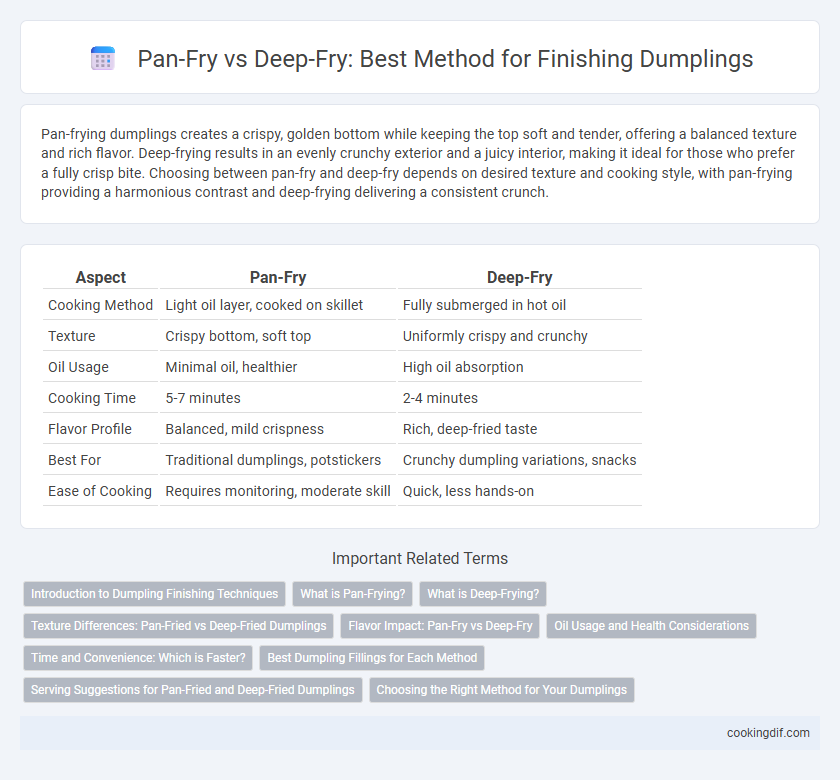Pan-frying dumplings creates a crispy, golden bottom while keeping the top soft and tender, offering a balanced texture and rich flavor. Deep-frying results in an evenly crunchy exterior and a juicy interior, making it ideal for those who prefer a fully crisp bite. Choosing between pan-fry and deep-fry depends on desired texture and cooking style, with pan-frying providing a harmonious contrast and deep-frying delivering a consistent crunch.
Table of Comparison
| Aspect | Pan-Fry | Deep-Fry |
|---|---|---|
| Cooking Method | Light oil layer, cooked on skillet | Fully submerged in hot oil |
| Texture | Crispy bottom, soft top | Uniformly crispy and crunchy |
| Oil Usage | Minimal oil, healthier | High oil absorption |
| Cooking Time | 5-7 minutes | 2-4 minutes |
| Flavor Profile | Balanced, mild crispness | Rich, deep-fried taste |
| Best For | Traditional dumplings, potstickers | Crunchy dumpling variations, snacks |
| Ease of Cooking | Requires monitoring, moderate skill | Quick, less hands-on |
Introduction to Dumpling Finishing Techniques
Pan-frying dumplings creates a crispy golden bottom while keeping the top tender and moist, offering a balanced texture ideal for potstickers. Deep-frying, by contrast, provides an evenly crunchy exterior with a rich, flavorful finish, making it popular for achieving a crispier, more indulgent bite. Both finishing techniques highlight different flavor profiles and textures, enhancing the versatility of dumplings in various culinary styles.
What is Pan-Frying?
Pan-frying dumplings involves cooking them in a shallow layer of oil over medium heat, creating a crispy bottom while keeping the top tender and steamed. This method allows for a perfectly balanced texture, combining a crunchy base with a soft, juicy filling. Pan-frying is ideal for potstickers, delivering a flavorful, golden crust without the greasiness associated with deep-frying.
What is Deep-Frying?
Deep-frying involves submerging dumplings completely in hot oil, typically heated between 325degF to 375degF, allowing for a crispy, evenly browned exterior and juicy interior. This cooking method quickly seals in moisture while creating a crunchy texture that contrasts with the soft filling, enhancing the overall flavor profile. Unlike pan-frying, deep-frying produces a more uniform crispness and a golden, crackling crust ideal for dumplings with thicker dough or richer fillings.
Texture Differences: Pan-Fried vs Deep-Fried Dumplings
Pan-fried dumplings have a crispy, golden-brown bottom with a soft, tender top, creating a contrast in textures that enhances each bite. Deep-fried dumplings feature a uniformly crunchy exterior, resulting in a more robust and consistently crispy texture throughout. The choice between pan-frying and deep-frying influences not only the dumpling's crunchiness but also its moisture retention and overall mouthfeel.
Flavor Impact: Pan-Fry vs Deep-Fry
Pan-frying dumplings enhances their flavor by creating a crispy, golden-brown bottom while retaining a tender, steamed top, resulting in a balanced texture and a rich, savory taste. Deep-frying delivers a uniformly crunchy exterior that intensifies the dumpling's flavor through caramelization and Maillard reactions, producing a more indulgent, oily profile. The choice between pan-fry and deep-fry significantly influences the flavor complexity and mouthfeel, catering to different culinary preferences.
Oil Usage and Health Considerations
Pan-frying dumplings requires significantly less oil, typically a few tablespoons, which results in lower calorie content and reduced fat intake, supporting heart health. Deep-frying submerges dumplings in oil, increasing oil absorption and caloric density, possibly contributing to higher cholesterol levels and cardiovascular risks. Choosing pan-fry for dumplings balances crispiness with healthier oil consumption compared to deep-fry methods.
Time and Convenience: Which is Faster?
Pan-frying dumplings typically takes about 8 to 10 minutes, combining a brief frying step and steaming to achieve a crispy bottom and tender top, making it a quick and convenient method. Deep-frying requires around 3 to 5 minutes to cook dumplings fully, offering a faster process but often involves more cleanup due to oil splatter and safety precautions. Choosing pan-frying balances speed and ease, while deep-frying is faster but less convenient in terms of preparation and cleanup.
Best Dumpling Fillings for Each Method
Pan-fried dumplings pair exceptionally well with pork and cabbage fillings that retain juiciness while developing a crispy, golden crust. Deep-fried dumplings benefit from heartier fillings like shrimp and vegetables or spiced chicken, which hold up well to the intense oil heat and deliver a crunchy texture. Choosing fillings with balanced moisture content enhances texture and flavor unique to each frying method.
Serving Suggestions for Pan-Fried and Deep-Fried Dumplings
Pan-fried dumplings offer a crispy, golden bottom with a soft, steamed top, making them ideal for serving with soy sauce, vinegar, and chili oil for dipping. Deep-fried dumplings deliver a uniformly crunchy texture, perfect for pairing with sweet and sour sauces or spicy mayo to enhance their richness. Both styles complement fresh scallions and sesame seeds as garnishes, adding flavor and visual appeal to the presentation.
Choosing the Right Method for Your Dumplings
Choosing the right cooking method for dumplings depends on texture and flavor preferences: pan-frying yields a crispy bottom with tender, steamed tops, ideal for potstickers, while deep-frying creates an evenly crunchy exterior with a richer taste. Pan-frying requires less oil and allows better control over cooking time and temperature, preserving dumpling fillings' juiciness. Deep-frying offers a golden, consistent shell perfect for party appetizers but can be heavier and less suitable for delicate wrappers.
Pan-fry vs Deep-fry for dumpling finishing Infographic

 cookingdif.com
cookingdif.com